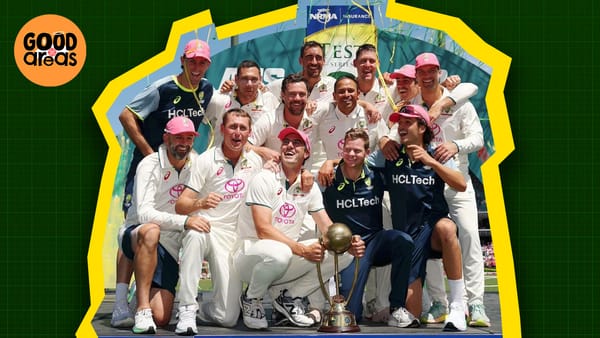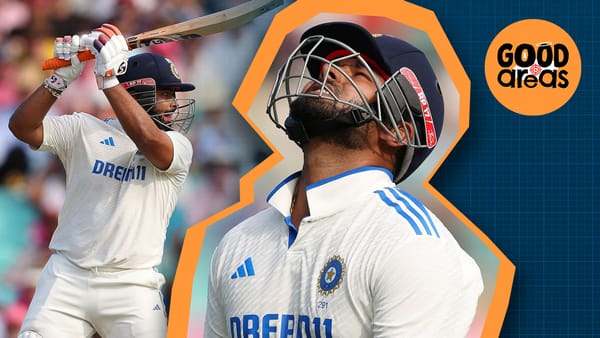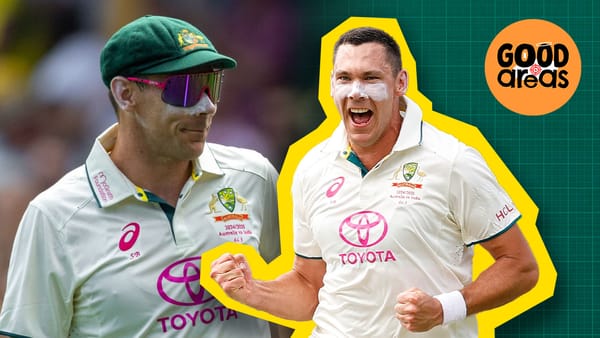The best and worst case for each team in the World Cup
How well will your team do in your dream? How bad will it go in reality?
What is the best and worst case scenario for each team for this World Cup? Because we need to be honest. The Netherlands are not entering this with a realistic chance of winning the tournament. Every team has their own range, and from this, it helps us understand what a good tournament for them looks like. And also a bad one.
So we have looked at every single team to look at why their high is, and then their low. We are including existing injuries, but we’re not factoring in what might happen with the kind of catastrophic injury luck Sri Lanka and England have had in recent T20 World Cups.
Now obviously this is not what will happen to your team, I can’t factor in the amount of banana skins South Africa will step on, or how Australia’s luck will magically come together at the right time. But with all we know, we can make a pretty good guess how good a tournament your team would have in a perfect world, and the actual results they may get in the dystopian world you live in.
Afghanistan

Best case - Afghanistan maximize their returns in the middle overs with both bat and ball. However, they are still not able to start or end well. Their batting is not good enough to win games. They win their 3 games at Lucknow and Chepauk, courtesy of their high-quality spin attack in conducive conditions and their batting doing enough. A three win Afghan team does play havoc with this tournament.
Worst case - They didn’t win a game last time. But considering conditions they are much better suited now. Their batting fails miserably, Rashid Khan does not have a great tournament, and they basically fall apart in their best phase with the ball. They probably still win the first game in their World Cup history against the Dutch in Lucknow.
Bangladesh

Best case - The great Najmul Shanto continues his excellent form. Their opening isn’t as horrendous as it has been, and their middle order scores enough runs to put par totals which allow you to compete against the mid-table teams. The all-round duo of Shakib al Hasan and Mehidy Hasan performs quite well. If this happens, they are on the verge of a semi-final, but I can’t see them getting in.
Worst case - Their batters do not score quick enough, and their bowling can’t take wickets. Then all hell breaks loose. I can’t see a world where they don’t defeat the Netherlands, but even Sri Lanka and Afghanistan with their solid bowling attacks prove to be too good for them.
Sri Lanka

Best case - Kusal Perera plays his shots at the start, while Pathum Nissanka plays the anchor role. Kusal Mendis, Sadeera Samawickrama and Charith Asanlaka consistently score runs in the middle overs. Skipper Shanaka finds his form and scores quick runs at the death. That is still only around a par batting lineup.
But their bowling takes ten wickets in a match four times, maybe five to get this record. That might sound far-fetched, but the spin-duo of Maheesh Theekshana and Dunith Wellalage looks incredible, while they also have decent seam options in Matheesha Pathirana and Lahiru Kumara. We initially had them on 5 wins before Wanindu Hasaranga and Dushmantha Chameera were ruled out of the final squad.
Worst case - Their batting just doesn’t hold up against any team apart from the Netherlands and Afghanistan. They fail to give their bowlers anything substantial to work with. Or their bowlers do well, but just take 6-7 wickets a game.
Netherlands

Best case - Their new ball bowlers - van Beek, van Meekeren and Klein take early wickets against a team which does not have a very strong middle order, and they are probably able to restrict them to a total within their range. Their middle works for once, the experience of van der Merwe and Ackermann stands up, while de Leede continues his ascension. Plus O’Dowd carries the top order in another World Cup.
Worst case - They just aren’t good enough to win against any of these teams in Asia. No team is set up worse for this tournament in terms of spin, bowling it, or batting against it. However, they may end up giving scares to big opponents, much like Afghanistan in 2019.
Pakistan

Best case - Fakhar Zaman finds form at the start of the World Cup. Imam ul Haq plays a little quicker and continues to score runs. Babar Azam does justice to his tag of being ICC’s number 1 ODI batter in men’s cricket. Mohammad Rizwan scores runs consistently in the middle overs. Iftikhar and Shadab hit out at the death.
Shaheen Afridi becomes their most reliable all-phase pacer in Naseem Shah’s absence. Haris Rauf continues to be the middle-overs enforcer and primary death-overs option. Along with Hasan Ali, he also covers up for Naseem’s role in the powerplay. Shadab Khan figures out a way to take wickets in the middle, or at least keep things tight along with Mohammad Nawaz as seamers strike. Hasan Ali rediscovers his 2017 self, and he also takes wickets in the middle overs.
Worst case - They bat too slow and their bowlers don’t take enough wickets in the middle. Naseem’s injury and the lack of a strike spin bowler means that they struggle to defend par totals against top teams. It probably ends up being a repeat of the 2019 campaign, when they missed out on NRR.
The Motley Fool helps millions of people attain financial freedom through our website, podcasts, books, and premium investing services.

India

Best case - India finally end their ICC trophy drought at home, continuing the streak of hosts winning the World Cup since they started it in 2011. They break free from the defensive approach that led to their downfall in knockouts over the last ten years.
Rohit Sharma and Shubman Gill continue their attacking approach in the powerplay and kick on from there. Virat Kohli is the glue which holds the batting lineup together. Shreyas Iyer tackles spinners in the middle, while KL Rahul and Hardik Pandya mould their game according to the match situation. The set batters make the most of the death-overs, and Ravindra Jadeja replicates his CSK death-over heroics.
Jasprit Bumrah and Mohammed Siraj wreak havoc with the new ball, with Mohammed Shami in the mix. Kuldeep Yadav takes a truckload of wickets in the middle overs, while Pandya and Jadeja keep things tight and maybe even chip in with wickets. Bumrah returns at the death, making life difficult for opponent batters. He is well-supported by Siraj, Pandya and maybe even Shami in that phase.
Worst case - India still end up making the semi-finals simply because they have high-quality players playing on home soil. However, they go back to their defensive approach in yet another pressure situation, come the knockouts. They lose early wickets, bat slow and score a below-par total. They don’t have a Plan B for when the opposition counter-attacks (read - CT17 final and Eng WC ‘19) their best bowlers.
Australia

Best case - David Warner and Mitch Marsh play the same attacking brand of cricket at the top. Steve Smith and Marnus Labuschagne fix their middle-overs problem by not losing too many wickets, and then scoring quickly after they’re set at the crease. Green, Maxwell and Carey go crazy at the death and just throw their bats at everything. They also have bowlers who can bat a bit in Cummins and Starc.
The pace trio of Starc-Cummins-Hazlewood starts off well in the powerplay, with Starc playing a key role there. Cummins is perhaps their all-phase bowler, while Hazlewood bowls most of his overs in the powerplay and death. Adam Zampa proves his worth as the best ODI spinner in this World Cup cycle by taking wickets consistently. Glenn Maxwell and Cam Green bowl the easier overs and keep the batters quiet. Starc, Hazlewood and Cummins also return at the death - giving barely any breathing space to opposition batters.
Worst case - Again, much like India, they still have the all-round quality and depth to make it to the top 4. However, Travis Head’s absence affects their powerplay performances. Smith and Labuschagne have a quiet tournament, where they don’t score a lot and they are slow. Maxwell is probably not a 100% fit, so that affects their all-round flexibility. The pace trio does not prove to be as effective on Indian soil. Adam Zampa isn’t quite the ‘mystery’ spinner which opponents would not look to take risks against. Their fifth bowlers get hammered. If they lose early wickets in a knockout match, it might just end up being a repeat of the 2019 semi-final where their batters just go into a shell.
England

Best case - Jonny Bairstow scores a lot of runs at the strike rate he usually does. Dawid Malan does his thing, though he does not score as fast as Roy. Joe Root finds his form on Indian pitches and has another 500+ runs World Cup campaign. Ben Stokes knocks the ball around till he decides it’s time to accelerate. He joins Jos Buttler and Liam Livingstone, as they absolutely decimate teams at the death. Their batting depth with Woakes at nine means that they bat fearlessly throughout. And we haven’t talked about the possibility of Brook in this XI.
Woakes and one of their left-arm seamers continue to take Powerplay wickets. Adil Rashid figures out the wicket-taking line and lengths, while Mark Wood tries to replicate the Plunkett middle-overs enforcer role (plus 10-15 kph). Moeen Ali and Liam Livingstone also chip in this phase. Sam Curran is able to bowl at the death, just like the previous T20 World Cup. And what if Jofra Archer manages to be a 100% fit, come the knockouts?
Worst case - Their batting depth and variety mean that they are still good enough to make it into the top 4. Their biggest fear in a knockout might be the lack of quality spinners and death bowling (like say Jofra Archer). We saw them lose to New Zealand in the World T20 with no good death bowling. Also, with Malan going up the order, Root has to find form, if he struggles Buttler and Livingstone have to bat against type.
South Africa

Best case - Temba Bavuma and Quinton de Kock maintain their good form at the top. They don’t lose early wickets. RVD and Markram milk the spinners in the middle overs, while Klaasen continues his dangerous hitting form. Miller and Klaasen essentially score at an absurd rate in the death overs.
Rabada becomes an all-phase monster in Nortje’s absence, and Jansen figures out a way to take early wickets. The spin duo of Maharaj and Shamsi bamboozles the opponents with their quality. Ngidi and Rabada come back to close the innings. It’s a good enough team for the final if it works.
Worst case - They lose wickets. No team is set up more for this not to happen. But They end up in situations where their top-order just collapses, and Marco Jansen comes out to bat at number 7. And that is followed by a tail that can barely contribute anything with the bat. They also don’t take early wickets, which is a problem when you’re facing a top-tier opponent.
New Zealand

Best case - Devon Conway finishes among the top run-getters in the tournament, utilizing his experience in the IPL. Kane Williamson and Daryl Mitchell guide New Zealand in the middle overs. Glenn Phillips scores quick runs in the middle and at the death. Tom Latham is the crisis man - in case of a top-order collapse.
Trent Boult and Matt Henry take early wickets. Ish Sodhi starts to take more middle-over wickets, while Mitch Santner keeps things tight. The experienced Tim Southee takes up an all-phase role.
They make the most out of their three fixtures against Bangladesh, India, and Australia in favourable conditions at the Dharamsala, and they secure a semis berth with victories against the lower-seeded teams. Their template for winning matches is scoring par totals and taking new ball wickets - proper percentage cricket. That may not hold up in the finals when the wickets probably won’t give as much new ball assistance.
Worst case - Will Young struggles in his first major assignment in India. Kane Williamson cannot make a proper return from an ACL injury that usually keeps you out for a year. This creates a lot of pressure on Devon Conway to bat through the innings. Latham bats slow. Glenn Phillips does not score a lot of quick runs. But their real big problem is that Santer gets hit, or milked, and they can’t trust another spinner for 5 overs a game, let alone ten. They still defeat the lower-ranked sides comfortably, but the lack of explosive batting and quality spin bowling means they have a mid-to-low table finish.
So based on all this we have tiers we can put the teams into. The top one is pretty easy, these are the teams of which you would assume the winner of the tournament will come. The next two are the teams who make a real run for the tournament with a couple of breaks.

New Zealand probably can’t win, but perhaps they can slip into the semi-finals and then who knows. Sri Lanka is probably 4a in this group, but everyone in this group is capable of beating the top teams, but probably not making the semi-finals. And the Netherlands is obviously a step down in these conditions.
South Africa are the best outsiders, and Afghanistan could be a magnificent spoiler, but the tournament is most likely going to be shared by the big three, again.




